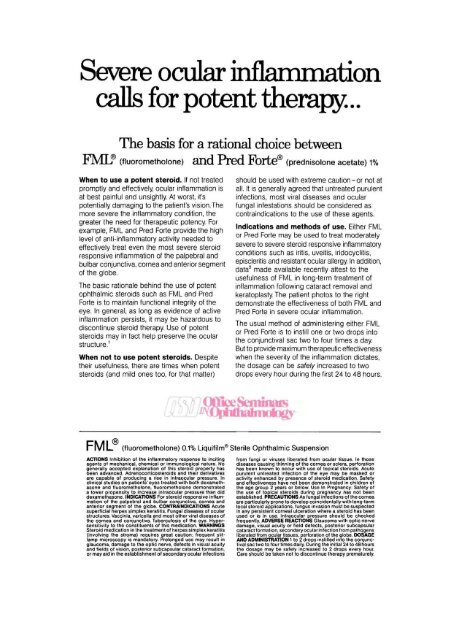Front Matter (PDF) - Investigative Ophthalmology & Visual Science
Front Matter (PDF) - Investigative Ophthalmology & Visual Science
Front Matter (PDF) - Investigative Ophthalmology & Visual Science
You also want an ePaper? Increase the reach of your titles
YUMPU automatically turns print PDFs into web optimized ePapers that Google loves.
Severe ocular inflammation<br />
calls for potent therapy...<br />
The basis for a rational choice between<br />
FML® (fluorometholone) and Pred Forte® (prednisolone acetate) 1%<br />
When to use a potent steroid. If not treated<br />
promptly and effectively, ocular inflammation is<br />
at best painful and unsightly. At worst, it's<br />
potentially damaging to the patient's vision. The<br />
more severe the inflammatory condition, the<br />
greater the need for therapeutic potency. For<br />
example, FML and Pred Forte provide the high<br />
level of anti-inflammatory activity needed to<br />
effectively treat even the most severe steroid<br />
responsive inflammation of the palpebral and<br />
bulbar conjunctiva, cornea and anterior segment<br />
of the globe.<br />
The basic rationale behind the use of potent<br />
ophthalmic steroids such as FML and Pred<br />
Forte is to maintain functional integrity of the<br />
eye. In general, as long as evidence of active<br />
inflammation persists, it may be hazardous to<br />
discontinue steroid therapy. Use of potent<br />
steroids may in fact help preserve the ocular<br />
structure. 1<br />
When not to use potent steroids. Despite<br />
their usefulness, there are times when potent<br />
steroids (and mild ones too, for that matter)<br />
should be used with extreme caution-or not at<br />
all. It is generally agreed that untreated purulent<br />
infections, most viral diseases and ocular<br />
fungal infestations should be considered as<br />
contraindications to the use of these agents.<br />
Indications and methods of use. Either FML<br />
or Pred Forte may be used to treat moderately<br />
severe to severe steroid responsive inflammatory<br />
conditions such as iritis, uveitis, iridocyclitis,<br />
episcleritis and resistant ocular allergy. In addition,<br />
data 2 made available recently attest to the<br />
usefulness of FML in long-term treatment of<br />
inflammation following cataract removal and<br />
keratoplasty. The patient photos to the right<br />
demonstrate the effectiveness of both FML and<br />
Pred Forte in severe ocular inflammation.<br />
The usual method of administering either FML<br />
or Pred Forte is to instill one or two drops into<br />
the conjunctival sac two to four times a day.<br />
But to provide maximum therapeutic effectiveness<br />
when the severity of the inflammation dictates,<br />
the dosage can be safely increased to two<br />
drops every hour during the first 24 to 48 hours.<br />
Seminais<br />
l~ IVIL_ (fluorometholone) 0.1% Liquifilm® Sterile Ophthalmic Suspension<br />
ACTIONS Inhibition of the inflammatory response to inciting<br />
agents of mechanical, chemical or immunological nature. No<br />
generally accepted explanation of this steroid property has<br />
been advanced. Adrenocorticosteroids and their derivatives<br />
are capable of producing a rise in intraocular pressure. In<br />
clinical studies on patients' eyes treated with both dexamethasone<br />
and fluorometholone, fluorometholone demonstrated<br />
a lower propensity to increase intraocular pressure than did<br />
dexamethasone. INDICATIONS For steroid responsive inflammation<br />
of the palpebral and bulbar conjunctiva, cornea and<br />
anterior segment of the globe. CONTRAINDICATIONS Acute<br />
superficial herpes simplex keratitis. Fungal diseases of ocular<br />
structures. Vaccinia, varicella and most other viral diseases of<br />
the cornea and conjunctiva. Tuberculosis of the eye. Hypersensitivity<br />
to the constituents of this medication. WARNINGS<br />
Steroid medication in the treatment of herpes simplex keratitis<br />
(involving the stroma) requires great caution; frequent slitlamp<br />
microscopy is mandatory. Prolonged use may result in<br />
glaucoma, damage to the optic nerve, defects in visual acuity<br />
and fields of vision, posterior subcapsuiar cataract formation,<br />
or may aid in the establishment of secondary ocular infections<br />
from fungi or viruses liberated from ocular tissue. In those<br />
diseases causing thinning of the cornea or solera, perforation<br />
has been known to occur with use of topical steroids. Acute<br />
purulent untreated infection of the eye may be masked or<br />
activity enhanced by presence of steroid medication. Safety<br />
and effectiveness have not been demonstrated in children of<br />
the age group 2 years or below. Use In Pregnancy: Safety of<br />
the use of topical steroids during pregnancy has not been<br />
established. PRECAUTIONS As fungal infections of the cornea<br />
are particularly prone to develop coincidentally with long-term<br />
local steroid applications, fungus invasion must be suspected<br />
in any persistent corneal ulceration where a steroid has been<br />
used or is in use. Intraocular pressure should be checked<br />
frequently. ADVERSE REACTIONS Glaucoma with optic nerve<br />
damage, visual acuity or field defects, posterior subcapsular<br />
cataract formation, secondary ocular infection from pathogens<br />
liberated from ocular tissues, perforation of the globe. DOSAGE<br />
AND ADMINISTRATION 1 to 2 drops instilled into the conjunctival<br />
sac two to four times daily. During the initial 24 to 48 hours<br />
the dosage may be safely increased to 2 drops every hour.<br />
Care should be taken not to discontinue therapy prematurely.

















